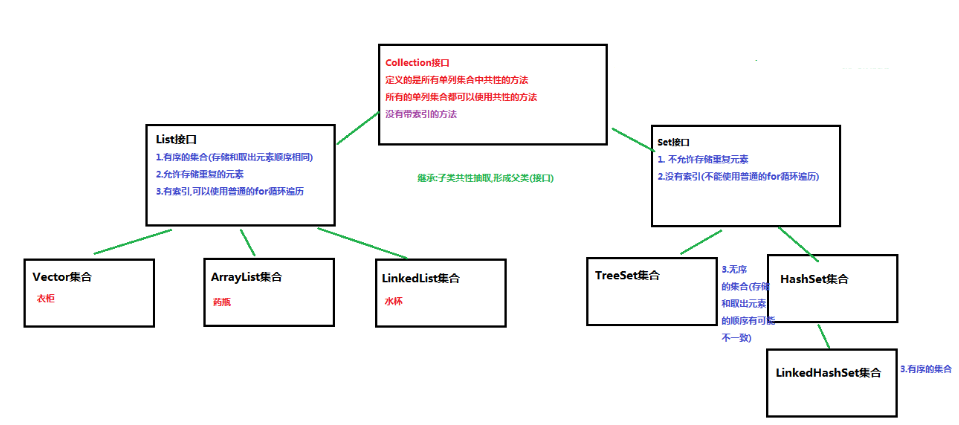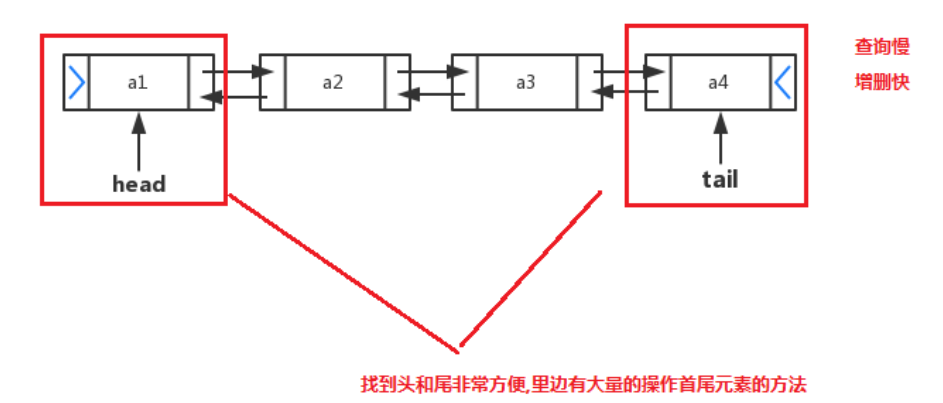一、集合概述
集合:集合是java中提供的一种容器,可以用来存储多个数据。
集合和数组既然都是容器,它们有啥区别呢?
* 数组的长度是固定的。集合的长度是可变的。
* 数组中存储的是同一类型的元素,可以存储基本数据类型值。
集合存储的都是对象。而且对象的类型可以不一致。在开发中一般当对象多的时候,使用集合进行存储。
集合按照其存储结构可以分为两大类,分别是单列集合`java.util.Collection`和双列集合`java.util.Map`,今天我们主要介绍`Collection`集合。
Collection:单列集合类的根接口,用于存储一系列符合某种规则的元素。
它有两个重要的子接口,分别是`java.util.List`和`java.util.Set`。
其中,`List`的特点是元素有序、元素可重复。`Set`的特点是元素无序,而且不可重复。
`List`接口的主要实现类有`java.util.ArrayList`和`java.util.LinkedList`,
`Set`接口的主要实现类有`java.util.HashSet`和`java.util.TreeSet`。

1)Collection常用方法
public boolean add(E e): 把给定的对象添加到当前集合中 。
public void clear() :清空集合中所有的元素。
public boolean remove(E e): 把给定的对象在当前集合中删除。
public boolean contains(E e): 判断当前集合中是否包含给定的对象。
public boolean isEmpty(): 判断当前集合是否为空。
public int size(): 返回集合中元素的个数。
public Object[] toArray(): 把集合中的元素,存储到数组中。
import java.util.ArrayList;
import java.util.Collection;
public class Demo1Collection {
public static void main(String[] args) {
// 创建集合对象
// 使用多态形式
Collection<String> coll = new ArrayList<String>();
// 使用方法
// 添加功能 boolean add(String s)
coll.add("小李广");
coll.add("扫地僧");
coll.add("石破天");
System.out.println(coll);
// boolean contains(E e) 判断o是否在集合中存在
System.out.println("判断 扫地僧 是否在集合中"+coll.contains("扫地僧"));
//boolean remove(E e) 删除在集合中的o元素
System.out.println("删除石破天:"+coll.remove("石破天"));
System.out.println("操作之后集合中元素:"+coll);
// size() 集合中有几个元素
System.out.println("集合中有"+coll.size()+"个元素");
// Object[] toArray()转换成一个Object数组
Object[] objects = coll.toArray();
// 遍历数组
for (int i = 0; i < objects.length; i++) {
System.out.println(objects[i]);
}
// void clear() 清空集合
coll.clear();
System.out.println("集合中内容为:"+coll);
// boolean isEmpty() 判断是否为空
System.out.println(coll.isEmpty());
}
}
二、list集合
List集合的特点:
1、有序集合
2、带有索引,通过索引可以精确的操作集合中元素
3、集合中可以有重复的元素,通过元素的equals方法,来比较是否为重复的元素。
常用方法

public class Test {
public static void main(String[] args) {
//创建list集合
List<String> list=new ArrayList<String>();
//往尾部添加指定元素
list.add("图图");
list.add("小妹");
list.add("不高兴");
//add(int index,String s)往指定位置添加
list.add(1,"没头脑");
//String remove(int index)删除指定位置的元素,返回被删除元素
System.out.println(list.remove(2));
//String set(int index,String s) 修改指定位置的元素
list.set(0, "三毛");
//跟size()方法一起用来遍历
for(int i=0;i<list.size();i++){
System.out.print(list.get(i)+" ");
}
System.out.println();
//使用增强for遍历
for(String string:list){
System.out.print(string+" ");
}
}

list的子类
1)ArrayList集合
java.util.ArrayList<E>类:该类需要导入后使用
<E>表示一种指定的数据类型,叫做泛型,表示我们要存储哪种引用类型的元素。
ArrayList<String>,ArrayList<Student>
基本格式:

2)LinkedList集合
![]()


public class LinkedListDemo {
public static void main(String[] args) {
LinkedList<String> link=new LinkedList<String>();
//添加元素
link.addFirst("abc1");
link.addFirst("abc2");
link.addFirst("abc3");
System.out.println(link);
//获取元素
System.out.println(link.getFirst());
System.out.println(link.getLast());
//删除元素
System.out.println(link.removeFirst());
System.out.println(link.removeLast());
while(!link.isEmpty()){//判断集合是否为空
System.out.println(link.pop());//弹出集合中的栈顶元素
}
System.out.println(link);
}
}

3)set集合
set集合特点
1、无序
2、不重复
Set集合子类
1)hashSet集合

public class HashSetDemo {
public static void main(String[] args) {
//创建set集合
HashSet<String> set=new HashSet<String>();
//添加元素
set.add(new String("abc"));
set.add("abc");
set.add("bca");
set.add("cba");
//遍历set
System.out.println(set);
for(String string:set){
System.out.print(string+" ");
}
}
}
 说明set中不能存储重复元素。
说明set中不能存储重复元素。
HashSet存储自定义类型
![]()
package test;
import java.util.Objects;
public class Student {
private String name;
private int age;
public Student(String name,int age){
this.name=name;
this.age=age;
}
public String getName() {
return name;
}
public void setName(String name) {
this.name = name;
}
public int getAge() {
return age;
}
public void setAge(int age) {
this.age = age;
}
@Override
public String toString() {
return "Student [name=" + name + ", age=" + age + "]";
}
@Override
public int hashCode() {
return Objects.hash(name,age);
}
@Override
public boolean equals(Object obj) {
if (this == obj)
return true;
if (obj == null||getClass() != obj.getClass())
return false;
Student student = (Student) obj;
return age==student.age && Objects.equals(name,student.name);
}
}
package test;
import java.util.HashSet;
public class test3 {
public static void main(String[] args) {
HashSet<Student> stuSet=new HashSet<Student>();
Student stu=new Student("于谦",43);
stuSet.add(stu);
stuSet.add(new Student("郭德纲",44));
stuSet.add(new Student("于谦",43));
stuSet.add(new Student("郭麒麟",23));
for(Student stu1:stuSet){
System.out.println(stu1);
}
}
}

2)LinkedHashSet
HashSet保证元素唯一,可是元素放进去没有顺序,保证元素有序,可以使用LinkedHashSet,它是链表和哈希表组合的一个数据存储结构。
public class LinkedHashSetDemo {
public static void main(String[] args) {
//创建set
Set<String> set=new LinkedHashSet<String>();
set.add("bbb");
set.add("aaa");
set.add("abc");
set.add("bbc");
Iterator<String> it=set.iterator();
while(it.hasNext()){
System.out.println(it.next());
}
}
}

3)collections类
java.utils.collections是集合工具类,用来对集合进行操作。
1)常用方法

public class CollectionDemo {
public static void main(String[] args) {
ArrayList<Integer> list=new ArrayList<Integer>();
//使用工具类一次性往集合中添加多个元素
Collections.addAll(list,5,222,1,2);
System.out.println(list);
//排序方法
Collections.sort(list);
System.out.println(list);
}
}

2)compare比较器
public class CollectionDemo {public static void main(String[] args) {ArrayList<Integer> list=new ArrayList<Integer>();//使用工具类一次性往集合中添加多个元素Collections.addAll(list,5,222,1,2);System.out.println(list);//排序方法Collections.sort(list);System.out.println(list);}
}